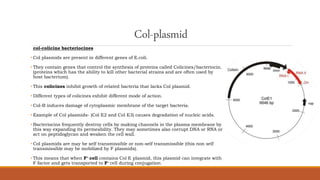Plasmids are double-stranded DNA molecules that exist independently of the chromosome in organisms. They can replicate on their own and provide benefits to the host such as antibiotic resistance. Plasmids come in different types based on their ability to transfer horizontally or their function. Common plasmid types include F-plasmids, which allow for bacterial conjugation, and R-plasmids, which contain antibiotic resistance genes. Plasmids are also useful as vectors in biotechnology as they contain origins of replication, antibiotic resistance genes, and multiple cloning sites that allow for insertion and expression of foreign DNA.












